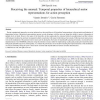Free Online Productivity Tools
i2Speak
i2Symbol
i2OCR
iTex2Img
iWeb2Print
iWeb2Shot
i2Type
iPdf2Split
iPdf2Merge
i2Bopomofo
i2Arabic
i2Style
i2Image
i2PDF
iLatex2Rtf
Sci2ools
NN
2006
Springer
2006
Springer
Perceiving the unusual: Temporal properties of hierarchical motor representations for action perception
Recent computational approaches to action imitation have advocated the use of hierarchical representations in the perception and imitation of demonstrated actions. Hierarchical representations present several advantages, with the main one being their ability to process information at multiple levels of detail. However, the nature of the hierarchies in these approaches has remained relatively unsophisticated, and their relation with biological evidence has not been investigated in detail, in particular with respect to the timing of movements. Following recent neuroscience work on the modulation of the premotor mirror neuron activity during the observation of unpredictable grasping movements, we present here an implementation of our HAMMER architecture using the minimum variance model for implementing reaching and grasping movements that have biologically plausible trajectories. Subsequently, we evaluate the performance of our model in matching the temporal dynamics of the modulation of...
Hierarchical Representations | Mirror Neuron Activity | Neural Networks | NN 2006 | Unpredictable Grasping Movements |
| Added | 14 Dec 2010 |
| Updated | 14 Dec 2010 |
| Type | Journal |
| Year | 2006 |
| Where | NN |
| Authors | Yiannis Demiris, Gavin Simmons |
Comments (0)

